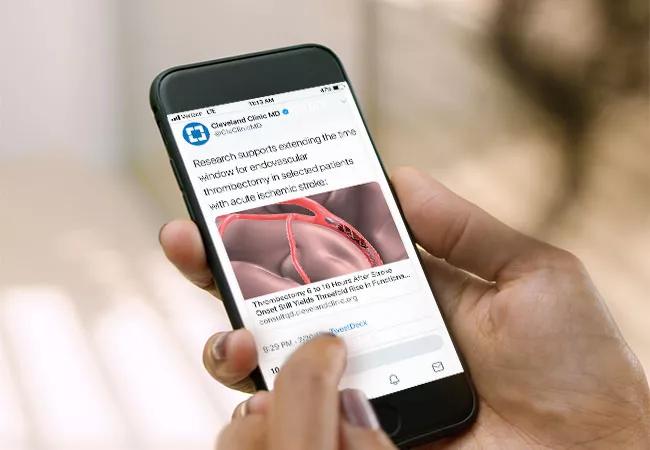Study looks for correlations in neurology research

It used to take decades of publishing for a medical researcher to gain recognition. Now, with social media, recognition can be almost instant.
Cleveland Clinic is a non-profit academic medical center. Advertising on our site helps support our mission. We do not endorse non-Cleveland Clinic products or services. Policy
The appeal of instant gratification — which can inspire further research — isn’t lost on the scientific community. Medical journals have begun publishing authors’ Twitter handles. Some journals ask authors to submit tweets with their articles. At scientific meetings, attendees post about research presentations in real time.
“There’s a push to share research on social media,” says Cleveland Clinic neurologist Vineet Punia, MD, MS, who until recently limited his social media activity to a personal Facebook account. “It made me wonder about the value of sharing. Does social media engagement increase the impact of scientific research?”
His question triggered a study recently published in JAMA Neurology on whether and how social media popularity (or “buzz”) correlates with academic impact.
“The purpose of research is not just to create knowledge, but to spread knowledge,” says Dr. Punia. “So, understanding how knowledge spreads — whether through social media or other means — should be important to researchers. Everyone wants to increase the influence of their work.”
Fortunately for the neuroscience community, neurology research tends to spread quickly on social media. More on that below. However, Dr. Punia’s study found that the number of blog posts, tweets and other mentions do little to boost academic clout.
Dr. Punia and colleagues compiled a list of all original research articles published in 2016 in five leading neurology journals:
Using the Dimensions (Digital Science & Research Ltd.) online research tool, they recorded each article’s Altmetric attention score as of 2019. This weighted score reflects the attention an article receives online — including mentions on social media, blogs and Wikipedia — and in mainstream media and public policy documents.
Of the 1,050 neurology research articles analyzed, the median Altmetric attention score was 18. Compare that to a similar study that found cardiovascular research articles had a median score of 8 (higher scores indicate greater attention).
Nearly half the neurology research articles (493 articles, 47%) had a score of 20 or higher. Only 5% of all research articles achieve an Altmetric attention score that high.
“I was pleasantly surprised at how much online attention neurology research gets,” says Dr. Punia. “I had always assumed that cardiovascular research gets the most.”
Next, the team recorded each article’s academic citations. The 1,050 articles had a median of 20 citations between 2016 and 2019.
According to analysis, the correlation between Altmetric attention score and number of citations was significant (P < 0.01) but weak (r = 0.32).
“While we were excited to learn about neurology’s online popularity, we were humbled to learn that it didn’t necessarily translate to academic popularity,” says Dr. Punia. “More tweets and other mentions don’t mean bigger academic impact.”
Of the 100 analyzed articles with the highest attention scores, more than one in four (n = 27) were about neurocognition topics, including memory issues and dementia.
Dr. Punia speculates that finding may be due to the public’s growing concern over a pending “dementia epidemic.” But he suspects there’s more to it.
“The brain is often called ‘the last frontier,’” he says. “It makes each of us unique, yet it’s the part of the body we understand least. That’s why the general public is so fascinated with any small finding that helps explain the brain or how brain health affects us. And that fascination is well deserved.”
This realization has prompted Dr. Punia not only to further his research but also to get a Twitter account. “I figured this study was a good first tweet,” he says.
He and his research team now are comparing the social media power of neurology subspecialties, such as neurocognition versus stroke. They hope to uncover why some subspecialties get more online traction by analyzing research articles’ geographic origin, study format and other factors, including scientific committees’ social media presence.
Future studies will involve mining social media data to understand how neurology research spreads online. Is it primarily through the neurology community, or does the general public also play a role?
“Ultimately, we want to know if there’s a correlation between spreading knowledge and improving patient outcomes,” says Dr. Punia. “If we find one, perhaps we can better target our social media activities.”

Large-scale joint study links elevated TMAO blood levels and chronic kidney disease risk over time

Investigators are developing a deep learning model to predict health outcomes in ICUs.

International collaboration is most genetically diverse study of the disease to date

Preclinical work promises large-scale data with minimal bias to inform development of clinical tests

Cleveland Clinic researchers pursue answers on basic science and clinical fronts

Study suggests sex-specific pathways show potential for sex-specific therapeutic approaches

Cleveland Clinic launches Quantum Innovation Catalyzer Program to help start-up companies access advanced research technology

Research project aims to pinpoint biomarkers that could speed diagnosis